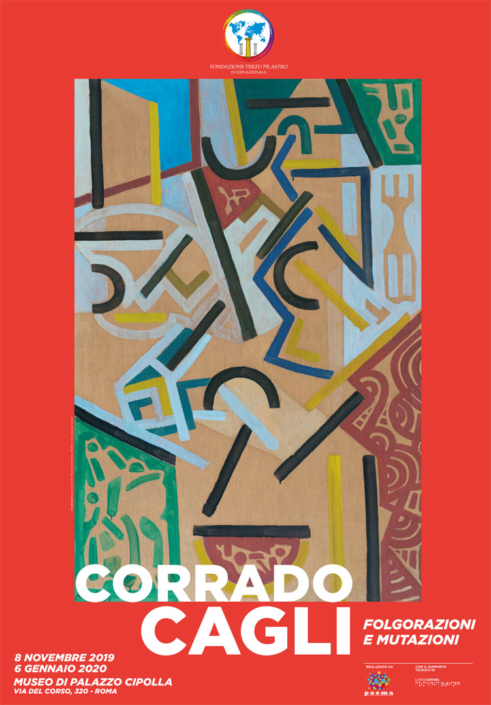CORRADO CAGLI
FOLGORAZIONI E MUTAZIONI
DESCRIPTION
Friday 8 November 2019 open to the public at Palazzo Cipolla Museum, Rome, the great anthological retrospective: Corrado Cagli. Folgorazioni e Mutazioni.
The exhibition at Palazzo Cipolla is dedicated to the Italian painter Corrado Cagli (1910-1976), remembered for forming the Scuola Romana art movement in the 1930s.
The exhibition is curated by Bruno Corà, President of the Fondazione Burri, in collaboration with the Archivio Cagli, promoted by the Terzo Pilastro Foundation – Internazionale, and organized by Poema S.p.A. with Comediarting.
The opening ceremony of the anthological retrospective exhibition titled ‘Corrado Cagli. Folgorazioni e Mutazioni’ dedicated to the vast oeuvre of Master Corrado Cagli was held in the prestigious halls of the Museo di Palazzo Cipolla, on via del Corso, Rome.
The exhibition is curated by Bruno Corà, art critic and historian, president of Fondazione Burri, in association with the Archivio Cagli and has been promoted by Fondazione Terzo Pilastro – Internazionale and organised Poema S.p.A. supported by Comediarting.
The exhibition features a vast collection of selected paintings as well as an extensive corpus of drawings, sculptures, sketches and theatrical costumes, tapestries and graphics totalling around 200 artworks from important institutions and prestigious private collections. The exhibition entirely reconstructs the creative activities performed by one of the major leaders of the Italian and international artistic debate in the XX century and brings Cagli back to Rome after his solo exhibition held in 1999 at the Galleria Archivio Arco Farnese curated by Fabio Benzi.
The exhibition allows the public to view the artist’s major pictorial cycles ranging from: his early works in majolica, works in oil or other media from the Scuola Romana period (1928 – 1938), Neo-Metaphysical sketches (1946 – 1927) produced in New York, studies on the Fourth Dimension (1949) Cellular Motifs (1949), direct and indirect Imprints (1950), the Ethereal Metamorphoses (1957 -1968), Orphic Variations (1957), the enthralling and enigmatic series of Cards (1958 -1963) to the Modular Mutations developed around the mid nineteen-seventies.
The curator Bruno Corà explains “Today Cagli’s art needs to be reconsidered, a new debate on the aesthetical language and thinking of this undisputed twentieth-century Master should be opened. This exhibition will allow us to investigate and attest, with the new critical appraisal tools available, the modernity of Cagli’s lesson, whose protean work never ceases to amaze viewers and stimulate artists and now calls for an digression on his continuous research and success.”
Professor Emmanuele F. M. Emanuele, Chairman of Fondazione Terzo Pilastro – Internazionale, which has promoted the exhibition, adds, “In the nineteen-thirties Gagli was already a leading figure of Italian art and represented the country in prestigious international exhibitions: many see him as privileged exponent of an Italian approach to modernity, on one hand an alternative to Futurism and on the other hand to traditional twentieth-century art. Later, his precarious circumstances and nomadic lifestyle during his exile in the United States led him to produce art with a ‘stylistic schizophrenia’ as defined by the essayist Raffaele Bedarida, which at the time made his works ‘significant on a personal level and not only’. Moreover, one of Gagli’s fundamental characteristic is certainly his constant effort to ‘contaminate’ his works by looking for cooperation beyond the borders of a single discipline: with men of letters as well as musicians, architects, mathematicians and many more. In this sense, he is a highly and incredibly contemporary artist and in my opinion it is important to remember and propose again, his constant, variegated and never trivial expressive research.”
The exhibition highlights several iconic moments of Cagli’s painting, such as those that aimed to give Italian Muralism an identity (in parallel with Sironi) in pursuit of “cyclical and polyphonic art”; several panels constituting the cycle exhibited and partially censored at the 1937 World Exposition in Pairs have been gathered for the occasion. There are also several works that were displayed in the exhibition held at the Studio d’Arte Palma when he returned from exile in the United States in 1947, which sparked a clash with the Forma group.
Finally, as well as the tapestries, plastic artworks, architectural sketches of the Fontana dello Zodiaco in Terni and the Göttingen Monument in Germany, visitors may also view the monumental cardboard mural painting executed for the XXI Venice Biennale held in 1938, Orpheus Charming the Beasts, and an important section centred on stage and theatrical costume designers, emphasising his experience at the New York Ballet Society together with George Balanchine.
The catalogue, published by Silvana editore and introduced by a critical essay by the curator Bruno Corà, with a preface by Professor Emmanuele F. M. Emanuele, also presents other contributions, including essays by Aldo Iori, Federica Pirani, Angelo Calabrese, Rita Olivieri, Marco Tonelli, Antonella Renzitti, Claudio Spadoni and Adachiara Zevi as well as a considerable critical historical apparatus and a selection of the artist’s writings curated by Giuseppe Briguglio from the Archivio Cagli of Rome.
The exhibition may be visited until the 6th of January 2020.
STAGES
ITALY. Rome, Palazzo Cipolla Museum – via del Corso, 320. 8 November 2019 – 6 January 2020




